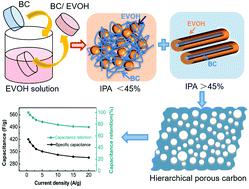Our official English website, www.x-mol.net, welcomes your
feedback! (Note: you will need to create a separate account there.)
Controlled preparation of interconnected 3D hierarchical porous carbons from bacterial cellulose-based composite monoliths for supercapacitors.
Nanoscale ( IF 5.8 ) Pub Date : 2020-06-23 , DOI: 10.1039/d0nr03591b Qiuhong Bai 1 , Yehua Shen , Taka-Aki Asoh , Cong Li , Yong Dan , Hiroshi Uyama
Nanoscale ( IF 5.8 ) Pub Date : 2020-06-23 , DOI: 10.1039/d0nr03591b Qiuhong Bai 1 , Yehua Shen , Taka-Aki Asoh , Cong Li , Yong Dan , Hiroshi Uyama
Affiliation

|
The controlled design and synthesis of porous carbons with anticipated microstructures and morphologies, and a high specific surface area (SSA) have been focused on for supercapacitor development. Here, hierarchical porous carbons (HPCs) with an interconnected three-dimensional morphology derived from a natural-based bacterial cellulose (BC) composite have been successfully prepared by thermally induced phase separation of poly(ethylene-co-vinyl alcohol) (EVOH) and subsequent carbonization/activation. The SSA and porous architectures can be controlled by fine-tuning the preparation conditions such as the precursor morphology and structure, activator dosage and activation temperature, and the relationships between the super-capacitive properties and the SSA and pore size distribution have been further investigated. The obtained porous carbon material possesses a hierarchical porous structure with moderate micropores, favorable mesopores, interconnected macropores, a high SSA of 2161 m2 g−1 and a maximum oxygen-dopant content of 9.99%, enabling an increase in the active materials utilization efficiency and wettability. Due to the synergistic effects of these features, the obtained porous carbon electrode used in a supercapacitor shows a high specific capacitance of 420 F g−1 at 0.5 A g−1, excellent rate performance with 75% capacitance retention at 20 A g−1, and good cycling stability with ∼96.1% retention even after 10 000 continuous charge–discharge cycles at 5 A g−1. Additionally, the assembled supercapacitor based on porous carbon displays a moderate energy density of 20 W h kg−1. The good electrochemical performance and facile effective synthesis of bio-derived carbon materials with tunable porous structures indicate promising applications in supercapacitors.
中文翻译:

从用于超级电容器的细菌纤维素基复合整体材料以受控方式制备互连的3D分层多孔碳。
具有预期的微结构和形态以及高比表面积(SSA)的多孔碳的受控设计和合成已经集中于超级电容器的开发。这里,分级多孔碳(高性能计算机)与互连从复合已通过聚热诱导相分离被成功制备的基于天然的细菌纤维素(BC)衍生的三维形貌(乙烯-共-乙烯醇(EVOH)和随后的碳化/活化。可以通过微调制备条件来控制SSA和多孔结构,例如前体的形态和结构,活化剂的用量和活化温度,并进一步研究了超电容性能与SSA和孔径分布之间的关系。所获得的多孔碳材料具有具有中等微孔,有利的中孔,相互连接的大孔,SSA为2161 m 2 g -1的高等级的多孔结构。最大氧掺杂剂含量为9.99%,从而提高了活性物质的利用效率和润湿性。由于这些特征的协同作用,获得的用于超级电容器的多孔碳电极在0.5 A g -1时显示出420 F g -1的高比电容,在20 A g -1时具有75%的电容保持率的优异倍率性能,即使在5 A g -1下进行10000次连续充放电循环后,仍具有良好的循环稳定性,保留率约为96.1%。另外,基于多孔碳的组装超级电容器显示出20 W h kg -1的中等能量密度。具有可调的多孔结构的生物衍生碳材料的良好电化学性能和容易有效的合成表明在超级电容器中具有广阔的应用前景。
更新日期:2020-07-23
中文翻译:

从用于超级电容器的细菌纤维素基复合整体材料以受控方式制备互连的3D分层多孔碳。
具有预期的微结构和形态以及高比表面积(SSA)的多孔碳的受控设计和合成已经集中于超级电容器的开发。这里,分级多孔碳(高性能计算机)与互连从复合已通过聚热诱导相分离被成功制备的基于天然的细菌纤维素(BC)衍生的三维形貌(乙烯-共-乙烯醇(EVOH)和随后的碳化/活化。可以通过微调制备条件来控制SSA和多孔结构,例如前体的形态和结构,活化剂的用量和活化温度,并进一步研究了超电容性能与SSA和孔径分布之间的关系。所获得的多孔碳材料具有具有中等微孔,有利的中孔,相互连接的大孔,SSA为2161 m 2 g -1的高等级的多孔结构。最大氧掺杂剂含量为9.99%,从而提高了活性物质的利用效率和润湿性。由于这些特征的协同作用,获得的用于超级电容器的多孔碳电极在0.5 A g -1时显示出420 F g -1的高比电容,在20 A g -1时具有75%的电容保持率的优异倍率性能,即使在5 A g -1下进行10000次连续充放电循环后,仍具有良好的循环稳定性,保留率约为96.1%。另外,基于多孔碳的组装超级电容器显示出20 W h kg -1的中等能量密度。具有可调的多孔结构的生物衍生碳材料的良好电化学性能和容易有效的合成表明在超级电容器中具有广阔的应用前景。









































 京公网安备 11010802027423号
京公网安备 11010802027423号